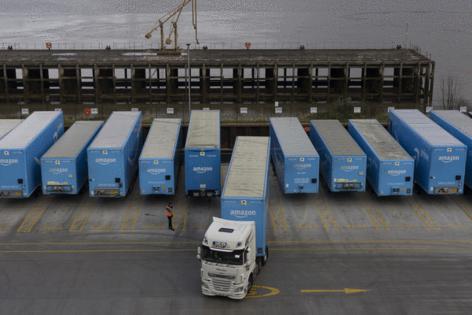Amazon turned drivers into first responders in Europe experiment
Published in Health & Fitness
Amazon.com Inc. equipped some delivery vans in Europe with defibrillators to see if drivers crisscrossing residential areas could speed up aid to heart-attack victims.
The world’s largest online retailer tested a program, called Project Pulse, as a pilot in Amsterdam in November 2023, and expanded it to London and Bologna, Italy, according to documents seen by Bloomberg. A few dozen drivers in each city carried the devices, which are made by Koninklijke Philips NV. The Dutch company partnered with Amazon for the trial.
Amazon confirmed that more than 100 contract drivers took part in the experiment, with several receiving alerts from citizen responder apps and arriving on site, where rescue services were already treating the victims. The pilot program concluded after several months, and the company is “evaluating the feedback and exploring additional opportunities for future programs,” said Amazon spokesperson Anneliese Hellwig-Schuster.
Automated external defibrillators are designed for ease of use. Pads attached to a victim’s chest recommend whether to administer a shock to restart the person’s heart. Nine out of 10 people live if they receive a jolt within a minute of a cardiac event, and chances of survival without CPR decrease by 10% every minute, according to the American Heart Association.
While many offices and public spaces stock AEDs, more than 70% of cardiac arrests occur in residential areas, according to the American Red Cross.
Amazon drivers who volunteer for the program are trained on the devices as part of a basic first-aid course that includes CPR. They enroll in local citizen responder networks, according to the documents, which alert them to suspected cases of nearby cardiac arrest.
In Paris, local first responder app “Staying Alive” trained dozens of Amazon drivers last year, according to its chief doctor, Paul Dardel. He hopes Amazon will fully roll out the program in France soon, but was told that expanding in the UK was the priority for now.
“This type of initiative is always a plus. If someone has a cardiac arrest, the more people trained and defibrillators available, the better,” Dardel said. “And for Amazon, it valorizes their image.”
The program’s most immediate objective would be to give everyone – not just Amazon customers – a better chance of surviving cardiac arrest, documents seen by Bloomberg show. Amazon vans tend to be closer than a professional first responder in many residential areas. A study by Philips included in the Amazon documents estimated that a fleet of 50 AED-equipped delivery vans on the roads of a north Seattle neighborhood would be able to respond more than a minute faster, on average, than emergency medical services.
Some within Amazon also saw a public relations upside to the program, according to the documents. The company’s drivers have been blamed for congestion, pollution and causing accidents. The program’s backers also speculated that Project Pulse could improve driver retention.
Amazon’s legal team deemed the risk of drivers being sued low owing to European laws that typically shield bystanders who come to someone’s aid.
One internal document estimated it would cost less than $17 million in the first year of the program to equip 15% of drivers at Amazon’s 1,100-plus last-mile delivery depots around the world. That rollout, initially targeted for 2024, hasn’t moved past the pilots tested in Europe. The company often sets overly ambitious goals in internal documents, some of which fall by the wayside owing to funding or employee constraints.
There’s precedent for the Amazon program. Philips partnered with Volvo in the Netherlands and aimed to deploy at least 25 AEDs, which were used 11 times in 6 months, including at least one life-saving intervention, according to Philips data cited by Amazon. The British Heart Foundation also tried equipping telecommunications field technicians with AEDs in 2021, likely saving one life.
In France, Dardel said he previously tried to partner with a taxi company, but that proved too complicated because cabs carry customers. Putting AED’s in delivery vehicles would be much simpler, he said, although the hardest part could be getting enough drivers to volunteer. Another potential hurdle: Amazon contract drivers have tight delivery schedules and demanding working conditions, fueling significant turnover.
Philips in January sold its emergency care unit, including AED manufacturing, to Bridgefield Capital, subject to regulatory approval, although a licensing agreement will allow the AEDs to retain the Philips brand globally for as long as 15 years. Philips has one plant in Bothell, Washington, not far from Amazon’s Seattle headquarters. The company is a close partner of Amazon’s retail and cloud-computing divisions.
____
—With assistance from Matt Day.
©2025 Bloomberg News. Visit at bloomberg.com. Distributed by Tribune Content Agency, LLC.










Comments